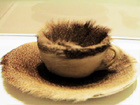 Sputnik 4 was a Soviet satellite, part of the Sputnik program and a test-flight of the Vostok spacecraft that would be used for the first human spaceflight. It was launched on May 15, 1960. (Sputnik 1 of course had been launched in 1957.)
Sputnik 4 was a Soviet satellite, part of the Sputnik program and a test-flight of the Vostok spacecraft that would be used for the first human spaceflight. It was launched on May 15, 1960. (Sputnik 1 of course had been launched in 1957.) A bug in the guidance system had pointed the capsule of this #4 in the wrong direction, so instead of dropping into the atmosphere the satellite moved into a higher orbit. It re-entered the atmosphere on or about September 5, 1962. A piece was found in the middle of a major street in Manitowoc, Wisconsin.
This spacecraft, the first of a series of spacecraft used to investigate the means for manned space flight, contained scientific instruments, a television system, and a self-sustaining biological cabin with a dummy of a man.
"I remember quite well the Sunday morning when the news of the launch of Sputnik-4 was announced," writes Sven Grahn. It really made big headlines and was seen as a first step to manned spaceflight, despite the fact that TASS clearly stated that the spacecraft would not be returned to earth."
Meantime, at Seattle University, the math department attributes to Sputnik the pressure to beef up the math-science faculty even if it meant violating some old taboos. And so Mary Turner, the first woman on the math faculty there, was hired. (She had also been the first woman to earn a doctorate in mathematics at the University of Chicago.)

 Is '60 the moment when the end of the end of the Old Left had been reached and the New Left began to emerge? Is it the final ascendancy, in certain scenes at least, of poetic postmodernity? Surely the publication of Donald Allen's The New American Poetry that year suggests this, but then again--once again--we look back on "New" here and see continuity. The rhetoric of the Kennedy-Nixon contest made much less of a dent than everyone (at the time as well as since) claimed, so one wonders why were such great claims made?
Is '60 the moment when the end of the end of the Old Left had been reached and the New Left began to emerge? Is it the final ascendancy, in certain scenes at least, of poetic postmodernity? Surely the publication of Donald Allen's The New American Poetry that year suggests this, but then again--once again--we look back on "New" here and see continuity. The rhetoric of the Kennedy-Nixon contest made much less of a dent than everyone (at the time as well as since) claimed, so one wonders why were such great claims made?  Had we come to expect "1960" to be truly ubiquitously modern in a way that the 1950s really were not--not quite? And what specifically does "modern" mean in the Kennedyesque talk then and now about the torch being passed to a new generation, etc.? The First Lady really meant "modernist" when Camelotians said "modern." What about the others across the new young cultural leadership? I've been surprised by how frequently the
Had we come to expect "1960" to be truly ubiquitously modern in a way that the 1950s really were not--not quite? And what specifically does "modern" mean in the Kennedyesque talk then and now about the torch being passed to a new generation, etc.? The First Lady really meant "modernist" when Camelotians said "modern." What about the others across the new young cultural leadership? I've been surprised by how frequently the  "Beat movement" was covered in 1960 in the mainstream press. I was expecting a fair measure but I've found tonnage. 1960 was the year when the figure of the beat was beginning to find acceptance, although still 80% of these stories are mocking, rebels-without-cause condescension. For anyone whose analysis made an impact nationally, do these antipolitical adolescents count as part of the "new young cultural leadership"? No, but rather than the two being opposites, they fall along a Continuum of the New American. Now that's a change for '60.
"Beat movement" was covered in 1960 in the mainstream press. I was expecting a fair measure but I've found tonnage. 1960 was the year when the figure of the beat was beginning to find acceptance, although still 80% of these stories are mocking, rebels-without-cause condescension. For anyone whose analysis made an impact nationally, do these antipolitical adolescents count as part of the "new young cultural leadership"? No, but rather than the two being opposites, they fall along a Continuum of the New American. Now that's a change for '60.







